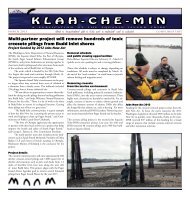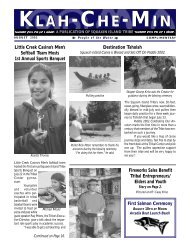Canoe Journey Guidebook - Squaxin Island Tribe
Canoe Journey Guidebook - Squaxin Island Tribe
Canoe Journey Guidebook - Squaxin Island Tribe
Create successful ePaper yourself
Turn your PDF publications into a flip-book with our unique Google optimized e-Paper software.
Support Boat<br />
Responsibilities<br />
BE RELIABLE—You need to be right there when the<br />
canoe you’re supporting needs you. That means you can’t<br />
be breaking down, so take care of necessary maintenance<br />
before the journey and have your systems working in top<br />
form. Have a good battery and charging system. Make sure<br />
your navigation lights work. Have a VHF radio that works.<br />
Have charts of the area, a GPS and know how to plot on<br />
charts if the fog rolls in. If you have a toilet, bring along a<br />
rebuild kit. Have tools and spare fuel filters handy.<br />
BE SEAWORTHY—Know what your boat can handle<br />
(probably more than you can). When you will REALLY be<br />
needed is when the westerly kicks out in the middle of<br />
the Strait of Juan de Fuca and you have to tow a canoe<br />
with your own boat full of wet and cold people in a rising<br />
and threatening sea. Make sure you, and your boat, are<br />
prepared for that. Be prepared to tow, and be able to do<br />
it quickly and efficiently. Have blankets and sunscreen<br />
aboard. Have a knife aboard if you wrap the prop. Have a<br />
good anchor setup and know how to use it. Be the expert<br />
with your boat that everyone expects you to be.<br />
BE SAFE—Make sure you can get people out of the water<br />
and into your support boat with relative ease - try it during<br />
a cold-water rescue training. Little rope ladders are useless<br />
because people can’t easily climb aboard with them - a<br />
steel ladder with at least three rungs down in the water<br />
is a workable solution. And you’ll still have to pull people<br />
aboard, but at least they can help get themselves in. Have<br />
a LifeSling or throwable life ring with poly attached (so it<br />
won’t sink and foul your prop), so you can haul a person to<br />
your boat. A throwing rope bag is a good way to get a line<br />
to a person in the water. Encourage float-vest usage - It is<br />
much safer for someone in the water to float without<br />
effort. It gives the support boat skipper something to pull<br />
them in with. Wear a float vest yourself to model good<br />
behavior and show that it isn’t that uncool. If the canoe<br />
flips, or the weather turns bad, the buck stops with you.<br />
You ARE who they will turn to.<br />
BE FUN—While you’ll be pushing your limits of navigation,<br />
anchoring and piloting skills (and parenting skills)<br />
you’ll be exploring new waters as part of an important<br />
cultural event. You’re an important member of the <strong>Canoe</strong><br />
Family, providing the canoes increased safety and convenience.<br />
Be flexible - it will come out alright, so long as<br />
you’re smiling.<br />
TEACH RESPECT—Kids can have fun and be respectful,<br />
too. You’re the master of your ship and responsible for all<br />
aboard, so make rules that work for your boat and stick<br />
to them. If smaller kids need to have their float-vests on<br />
every time they’re out of the cockpit, enforce that. If they<br />
make a mess down below, make them pick it all up before<br />
stepping onto the dock. Most people like to know what<br />
the rules are so they can follow them - they want to do the<br />
right thing - so let them know your rules and be consistent<br />
in applying them. It’s OK to be a parent when needed,<br />
but you have too much to do to be a cop. Model good<br />
behavior at all times - they’re looking to you much more<br />
than you think. People think that a canoe journey is about<br />
pulling in the canoe, but it’s so much more than that -<br />
seeing how protocol works, seeing how people get along,<br />
its seeing how the <strong>Canoe</strong> Family provides duties for everyone<br />
so everyone has a place and is needed.<br />
Submitted upon request by Tom Curly<br />
BE DISCREET—This is a canoe journey, not a support<br />
boat journey. Fall back a bit and don’t be the center of<br />
attention, but be close enough to respond quickly when<br />
your canoe hails. Take care of your own needs (fuel, water,<br />
moorage, potty dump) after the canoes have landed. Make<br />
sure you have lunches and drinks aboard in the morning<br />
before departure. Cell phones and FRS radios are a good<br />
way to stay in touch.<br />
37 • paddle to squaxin 2012

















